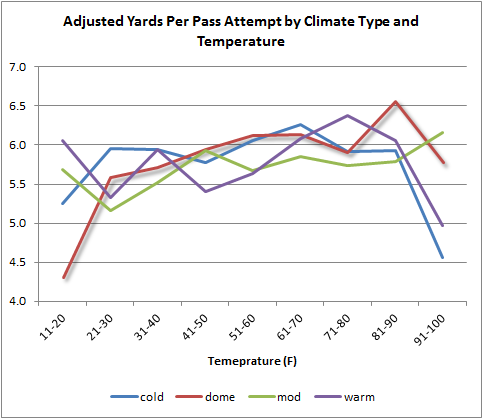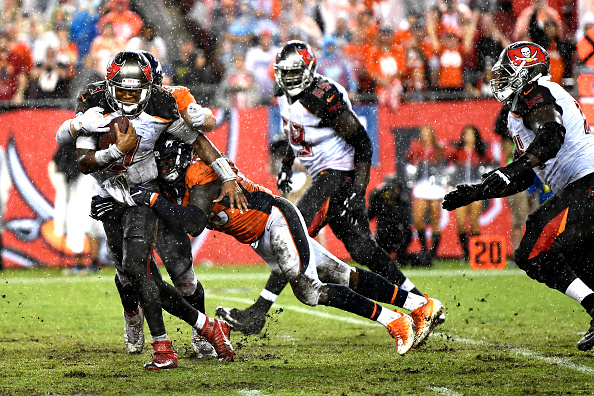 It’s no secret that weather is a factor fantasy players, both season-long and daily, should consider when making roster decisions. A lot of fantasy sites provide detailed weather information these days (including this one, of course), and there are Twitter accounts dedicated exclusively to providing weather analysis to fantasy players.
It’s no secret that weather is a factor fantasy players, both season-long and daily, should consider when making roster decisions. A lot of fantasy sites provide detailed weather information these days (including this one, of course), and there are Twitter accounts dedicated exclusively to providing weather analysis to fantasy players.
If you play fantasy baseball, you know that everything from rain to wind to temperature to humidity can influence production. Most of these factors matter in fantasy football as well but in different ways.
Instead of looking for heat that can boost offensive production in baseball, fantasy football players are more concerned with cold that can restrict offensive production.
Instead of looking to see if the wind is blowing in or out in baseball, fantasy football players are more concerned with whether a stiff wind is blowing in any direction as it can negatively affect offense.
Instead of trying to avoid the risk of delay or postponement that precipitation can cause in baseball, fantasy football players are more concerned with how rain affects production since they’ll generally play through it on the gridiron.
Let’s first dig into temperatures as there have been some good, thorough studies on the subject done by smarter people with better data than the current author. For starters, John Paulsen has found that cold weather doesn’t negatively impact scoring like you might assume. Among the almost 4,000 regular season games played from 1994-2015, 327 were played in freezing temperatures, and the scoring average in those games was actually higher than it was for all games played in those seasons.
Interestingly, the 301 games played at 80 degrees or above in that time frame had a lower scoring average than the overall sample. But it should be noted that the “higher” scoring average of the cold games and the “lower” scoring average of the warm games did not deviate much from the scoring average of the entire sample. The point here isn’t that you should target or avoid games of a certain temperature based on temperature alone but that the temperature on its own isn’t much of a factor.
When temperatures do seem to have an effect is when road teams travel to a host city with conditions that do not resemble those of the road team’s home city. Brian Burke has done research on how temperature affects road teams and found that dome teams and, to a lesser extent, warm weather teams struggle to win games on the road in cold temperatures. Being on the road is a negative for players each week in general, but if you add in cold temps for dome/warm weather teams, it’s a further negative mark on their ledger.
Specifically, passing is negatively affected when dome/warm weather teams play in cold temps. From a separate piece by Burke, the chart below shows yards per pass attempt by climate type in different temperatures.

As you can see, dome/warm weather teams are a bit more affected in colder temps. But you can also see a general upward trend for teams of all climate types as temperatures increase until we hit the extreme warm temperatures. Given the research above showing that cold weather does not have a negative impact on scoring and this chart that shows it does negatively affect passing, it’s reasonable to assume that the ground game is positively affected in colder weather.
While temperatures affect dome/warm weather road teams more specifically than they do the league at large, wind seems to affect all teams equally. From the same article as the chart above, here is a chart showing the impacts of wind on yards per attempt by team climate type.

Aside from an anomalous spike for dome teams at 15-19 mph, there’s a general downward trend for teams from all climate types. This jives with the consensus you hear from the fantasy community. In the first linked piece above from Paulsen, he notes that he adjusts his projections for high winds exceeding 20 mph. And here’s DFS weatherman Kevin Roth on the issue of wind:

While we’re here, it’s reasonable to assume this negative effect of wind applies to kickers in addition to the passing game.
The last piece of Burke’s linked article above also shows that, unsurprisingly, passing plays are called less frequently as wind speeds increase, which means that, conversely, running plays are called more. Finding volume at running back is a key part of fantasy football, so games with colder temps and/or higher winds are spots to exploit for additional volume.
As for rain, Krishna Narsu has found that the difference in total QBR when it rains and when it does not is statistically significant. This is yet another example of evidence showing that the passing game is negatively affected when there is some weather element in play. But outside of a torrential downpour or a blizzard, it’s not clear that precipitation has a negative effect on the running game.
The TLDR version of this article says to downgrade the passing game when:
- A team from a dome/warm weather city is on the road playing in cold temperatures;
- A team, any team, is playing high winds; and
- A team is playing in the rain.
But do not knock the ground game when it comes to extremely cold temperatures or rain outside of the worst possible conditions.
It probably goes without saying, but season-long players should not go looking at team schedules trying to identify teams that tend to play in high winds frequently at home or teams from dome/warm weather cities that have road games in cold weather cities late in the season. People who get paid to predict the weather for a living can hardly do it accurately when putting out a three-day forecast much less months down the road.
It’s week-to-week where weather really matters. It’s probably a bit more applicable to DFS players since they literally have the entire player pool available to them each week from which to roster players. But weather can matter for season-long players as well. In close start/sit decisions weather could be the deciding factor, and it could steer you in the right direction if you’re using the waiver wire for streaming purposes at QB, TE, D/ST or K.

